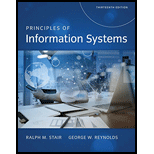
Principles of Information Systems (MindTap Course List)
13th Edition
ISBN: 9781305971776
Author: Ralph Stair, George Reynolds
Publisher: Cengage Learning
expand_more
expand_more
format_list_bulleted
Concept explainers
Question
Chapter 10.1, Problem 1RQ
Program Plan Intro
Knowledge management:
- Knowledge management is the set of practices that are alarmed with:
- Increasing awareness
- Developing learning
- Speeding teamwork
- Innovation and
- Exchange insights
- The aim of knowledge management is to gather and document the valuable tacit knowledge of others and turn that into an explicit knowledge so that it can be shared with others.
Types of knowledge management: There are two types of knowledge management. They are:
- Explicit knowledge:
- Explicit knowledge is an expressive knowledge that can be articulated, accessed, documented, and codified.
- It is expressed in terms of words, symbols, and numbers.
- This knowledge is easily conveyed to others. It is stored in media.
- Tacit knowledge:
- It cannot be documented like explicit knowledge rather it is embedded according to the experiences of the individuals.
- It is unwritten and has hidden knowledge.
- It is hard to transfer to other individuals because it is difficult to verbalize.
Expert Solution & Answer
Trending nowThis is a popular solution!

Students have asked these similar questions
Discrete Mathematics for Computer Engineering
this module is java 731 . make sure my answers are 1005 correct and the layout and structure is perfect and also include all comments etc. thank you
i have attached question 1 (40 marks) and question 2 (30 marks )
this is question 3:
Question3: (30 MARKS) Passenger Rail Agency for South Africa Train Scheduling System Problem Statement Design and implement a train scheduling system for Prasa railway network. The system should handle the following functionalities: 1. Scheduling trains: Allow the addition of train schedules, ensuring that no two trains use the same platform at the same time at any station. 2. Dynamic updates: Enable adding new train schedules and canceling existing ones. 3. Real-time simulation: Use multithreading to simulate the operation of trains (e.g., arriving, departing). 4. Data management: Use ArrayList to manage train schedules and…
this module is java 731 . make sure my answers are 1005 correct and the layout and structure is perfect and also include all comments etc. thank you
i have attached question 1 (40 marks) and question 2 (30 marks )
this is question 3:
Question3: (30 MARKS) Passenger Rail Agency for South Africa Train Scheduling System Problem Statement Design and implement a train scheduling system for Prasa railway network. The system should handle the following functionalities: 1. Scheduling trains: Allow the addition of train schedules, ensuring that no two trains use the same platform at the same time at any station. 2. Dynamic updates: Enable adding new train schedules and canceling existing ones. 3. Real-time simulation: Use multithreading to simulate the operation of trains (e.g., arriving, departing). 4. Data management: Use ArrayList to manage train schedules and…
Chapter 10 Solutions
Principles of Information Systems (MindTap Course List)
Ch. 10.1 - Prob. 1RQCh. 10.1 - Prob. 2RQCh. 10.1 - Prob. 1CTQCh. 10.1 - Prob. 2CTQCh. 10.2 - Prob. 1RQCh. 10.2 - Prob. 2RQCh. 10.2 - Prob. 1CTQCh. 10.2 - Prob. 2CTQCh. 10.3 - Do research to find out how the school can sign up...Ch. 10.3 - Prob. 2RQ
Ch. 10.3 - Prob. 1CTQCh. 10.3 - What potential barriers to implementing this...Ch. 10.4 - What sort of training and experience is needed by...Ch. 10.4 - Prob. 2RQCh. 10.4 - Prob. 1CTQCh. 10.4 - Prob. 2CTQCh. 10 - Prob. 1SATCh. 10 - Prob. 2SATCh. 10 - Prob. 3SATCh. 10 - Prob. 4SATCh. 10 - Prob. 5SATCh. 10 - Prob. 6SATCh. 10 - Prob. 7SATCh. 10 - Prob. 8SATCh. 10 - Prob. 9SATCh. 10 - Prob. 10SATCh. 10 - Prob. 11SATCh. 10 - Prob. 12SATCh. 10 - Prob. 13SATCh. 10 - Prob. 14SATCh. 10 - Prob. 15SATCh. 10 - Prob. 16SATCh. 10 - Prob. 17SATCh. 10 - Prob. 1RQCh. 10 - Prob. 2RQCh. 10 - Prob. 3RQCh. 10 - Prob. 4RQCh. 10 - Prob. 5RQCh. 10 - Prob. 6RQCh. 10 - Prob. 7RQCh. 10 - Prob. 8RQCh. 10 - Prob. 9RQCh. 10 - Prob. 10RQCh. 10 - Prob. 11RQCh. 10 - Prob. 12RQCh. 10 - Prob. 13RQCh. 10 - Prob. 14RQCh. 10 - Prob. 15RQCh. 10 - Prob. 16RQCh. 10 - Prob. 17RQCh. 10 - Prob. 18RQCh. 10 - Prob. 19RQCh. 10 - Prob. 20RQCh. 10 - Prob. 21RQCh. 10 - Prob. 22RQCh. 10 - Prob. 23RQCh. 10 - Prob. 1DQCh. 10 - Prob. 2DQCh. 10 - Prob. 3DQCh. 10 - Prob. 4DQCh. 10 - Prob. 5DQCh. 10 - Prob. 6DQCh. 10 - Prob. 7DQCh. 10 - Prob. 8DQCh. 10 - Prob. 9DQCh. 10 - Prob. 10DQCh. 10 - Prob. 11DQCh. 10 - Prob. 12DQCh. 10 - Prob. 13DQCh. 10 - Prob. 1PSECh. 10 - Prob. 3PSECh. 10 - Prob. 3TACh. 10 - Prob. 2WECh. 10 - Prob. 3WECh. 10 - Prob. 1CECh. 10 - Prob. 3CECh. 10 - Prob. 1CTQ1Ch. 10 - Prob. 2CTQ1Ch. 10 - Prob. 3CTQ1Ch. 10 - Prob. 4CTQ1Ch. 10 - Prob. 5CTQ1Ch. 10 - Prob. 1CTQ2Ch. 10 - Prob. 2CTQ2Ch. 10 - Prob. 3CTQ2
Knowledge Booster
Learn more about
Need a deep-dive on the concept behind this application? Look no further. Learn more about this topic, computer-science and related others by exploring similar questions and additional content below.Similar questions
- this module is java 731 . make sure my answers are 1005 correct and the layout and structure is perfect and also include all comments etc. thank you i have attached question 1 (40 marks) and question 2 (30 marks ) this is question 3: Question3: (30 MARKS) Passenger Rail Agency for South Africa Train Scheduling System Problem Statement Design and implement a train scheduling system for Prasa railway network. The system should handle the following functionalities: 1. Scheduling trains: Allow the addition of train schedules, ensuring that no two trains use the same platform at the same time at any station. 2. Dynamic updates: Enable adding new train schedules and canceling existing ones. 3. Real-time simulation: Use multithreading to simulate the operation of trains (e.g., arriving, departing). 4. Data management: Use ArrayList to manage train schedules and…arrow_forwardDiscrete Mathematics for Computer Engineeringarrow_forwardTask 1: Write an abstract class Method +: public -: private #: protected Underline: static # input: int # output:String Method + isHard():boolean + specificWay():String + Method() + Method(input: int, output: String) + getInput(): int + setInput(input: int): void + getOutput(): String + setOutput(output: String): void +toString(): String Question Task 2: Write a class ReadMethod that extends the Method class. +: public -: private #: protected Underline: static -language: String ReadMethod Question + ReadMethod() + ReadMethod(input: int, output: String, language: String) + isHard():boolean + specific Way(): String +toString(): String + getLanguage(): String + setLanguage(language: String): voidarrow_forward
- i have attatched my java question , please make sure it is answered correct, include all comments etc, thank youarrow_forwardi have attached my 2 java questions . please answer them correctly, add all comments etc . thank you.arrow_forwardCan you help me solve this problem using Master's Theorem:Solve the recurrence relation f(n) = 3af(n/a) + (n + a)2 with f(1) = 1 and a > 1 byfinding an expression for f(n) in big-Oh notation.arrow_forward
- here is example 7.6## Example 7.6 Suppose the sample population is χ 2 (2), which is non-normal but with same variance 4. ▶ Repeat the simulation, but replacing the N(0, 4) samples with χ 2 (2) samples. ▶ Calculate the empirical confidence level.(Empirical confidence level) n <- 20 alpha <- 0.05 UCL <- replicate(1000, expr = { x <- rchisq(n,df=2) (n-1)*var(x)/qchisq(alpha,df=n-1) }) sum(UCL >4) mean(UCL > 4) ## t.test function n <- 20 x <- rnorm(n,mean=2) result <- t.test(x,mu=1) result$statistic result$parameter result$p.value result$conf.int result$estimatearrow_forwardusing r languagearrow_forwardusing r languagearrow_forward
- Describe a business example where referential integrity avoids data problems. specifying in the description of what the problems are and how they can be avoided. thaksarrow_forwardHow do the concepts of balancing and leveling affect the process of creating a data model of a system? thanksarrow_forwardwhat is the relationship between a Context Diagram and Diagram 0 in the DFD process. I need to Use an examplearrow_forward
arrow_back_ios
SEE MORE QUESTIONS
arrow_forward_ios
Recommended textbooks for you
 Principles of Information Systems (MindTap Course...Computer ScienceISBN:9781305971776Author:Ralph Stair, George ReynoldsPublisher:Cengage Learning
Principles of Information Systems (MindTap Course...Computer ScienceISBN:9781305971776Author:Ralph Stair, George ReynoldsPublisher:Cengage Learning Fundamentals of Information SystemsComputer ScienceISBN:9781337097536Author:Ralph Stair, George ReynoldsPublisher:Cengage Learning
Fundamentals of Information SystemsComputer ScienceISBN:9781337097536Author:Ralph Stair, George ReynoldsPublisher:Cengage Learning A+ Guide To It Technical SupportComputer ScienceISBN:9780357108291Author:ANDREWS, Jean.Publisher:Cengage,
A+ Guide To It Technical SupportComputer ScienceISBN:9780357108291Author:ANDREWS, Jean.Publisher:Cengage, Management Of Information SecurityComputer ScienceISBN:9781337405713Author:WHITMAN, Michael.Publisher:Cengage Learning,
Management Of Information SecurityComputer ScienceISBN:9781337405713Author:WHITMAN, Michael.Publisher:Cengage Learning, Principles of Information Systems (MindTap Course...Computer ScienceISBN:9781285867168Author:Ralph Stair, George ReynoldsPublisher:Cengage Learning
Principles of Information Systems (MindTap Course...Computer ScienceISBN:9781285867168Author:Ralph Stair, George ReynoldsPublisher:Cengage Learning Information Technology Project ManagementComputer ScienceISBN:9781337101356Author:Kathy SchwalbePublisher:Cengage Learning
Information Technology Project ManagementComputer ScienceISBN:9781337101356Author:Kathy SchwalbePublisher:Cengage Learning

Principles of Information Systems (MindTap Course...
Computer Science
ISBN:9781305971776
Author:Ralph Stair, George Reynolds
Publisher:Cengage Learning

Fundamentals of Information Systems
Computer Science
ISBN:9781337097536
Author:Ralph Stair, George Reynolds
Publisher:Cengage Learning

A+ Guide To It Technical Support
Computer Science
ISBN:9780357108291
Author:ANDREWS, Jean.
Publisher:Cengage,

Management Of Information Security
Computer Science
ISBN:9781337405713
Author:WHITMAN, Michael.
Publisher:Cengage Learning,

Principles of Information Systems (MindTap Course...
Computer Science
ISBN:9781285867168
Author:Ralph Stair, George Reynolds
Publisher:Cengage Learning

Information Technology Project Management
Computer Science
ISBN:9781337101356
Author:Kathy Schwalbe
Publisher:Cengage Learning